"For black lives to matter, black history has to matter." A character says this shortly into the first episode of Luke Cage, Netflix's third MCU series, and the fourth season of television it has produced in collaboration with Marvel as it ramps up for its Defenders mega- event. It's easy to read this line as a thesis statement on the nature of the show we're about to watch, but it's not until
Add a CommentViewing: Blog Posts Tagged with: superheroes, Most Recent at Top [Help]
Results 1 - 25 of 117
Blog: Asking the Wrong Questions (Login to Add to MyJacketFlap)
JacketFlap tags: television, essays, superheroes, marvel cinematic universe, Add a tag
Blog: Children's Book Reviews and Then Some (Login to Add to MyJacketFlap)
JacketFlap tags: Picture Books, Superheroes, Add a tag
 Kristy Dempsey and Mark Fearing join forces to deliver the Superhero Instruction Manual! Despite the comic book feel and solid set of instructions, the Superhero Instruction Manual remains wonderfully free of conflict and violence, instead delivering a wonderful story of familial love.
Kristy Dempsey and Mark Fearing join forces to deliver the Superhero Instruction Manual! Despite the comic book feel and solid set of instructions, the Superhero Instruction Manual remains wonderfully free of conflict and violence, instead delivering a wonderful story of familial love.Blog: Asking the Wrong Questions (Login to Add to MyJacketFlap)
JacketFlap tags: superheroes, x-men, film, essays, Add a tag
I promise, at some point I'll go back to writing about things that aren't superheroes. Though that would require Hollywood to stop blasting superhero stories at us in such close succession (I haven't even written anything about the second season of Daredevil, though you can get a sense of the existential despair it plunged me into from the thread starting at this tweet). Coming at the end of
Add a CommentBlog: Asking the Wrong Questions (Login to Add to MyJacketFlap)
JacketFlap tags: film, essays, superheroes, captain america, marvel cinematic universe, Add a tag
It's a bit of a strange thing to say, but I might have liked Captain America: Civil War better if it were a less good movie. When films like The Dark Knight Rises or Batman v Superman: Dawn of Justice deliver rancid political messages wrapped in equally rancid plots and characterization, the reviewer's job is made easier. We can point to how a failure to recognize the actual complexity of a
Add a CommentBlog: Asking the Wrong Questions (Login to Add to MyJacketFlap)
JacketFlap tags: film, essays, superman, superheroes, batman, Add a tag
To get the obvious stuff out of the way, Batman v Superman: Dawn of Justice is a terrible movie. I mean, you didn't need me to tell you that, right? It's been out for three weeks, and the reviews have been so uniformly terrible that its 28% freshness rating on Rotten Tomatoes actually seems a bit high. And before that consensus formed, there were the pre-release reviews, which were if anything
Add a CommentBlog: Welcome to my Tweendom (Login to Add to MyJacketFlap)
JacketFlap tags: Friendship, rivalry, superheroes, Random House, girl power, high school, competition, 2016, Add a tag
This super cutie book showed up in the post the other day, and I promptly snagged it to take it home. I constantly on the look-out for all things super hero, and when there is a girl power theme, I'm all for it. Plus, Lisa Yee? I'm all in.
Wonder Woman has lived on Paradise Island with her mother her whole life, and she has been happy there. But Wonder Woman actually goes behind Hippolyta's back and applies to Super Hero High. It's not that Wonder Woman wants to leave home and her mother, but she does want to spread her wings and figure out who she is.
Wonder Woman is ecstatic when she finds out she is accepted, and is even more thrilled when her mother lets her go.
The thing is, Wonder Woman hasn't exactly been around the block. Have you ever met someone who takes everything literally? Well, that is Wonder Woman to a "t"! When she is told to get a clue she goes looking for one! Imagine moving from Paradise Island to being roomies with vlog obsessed Harley Quinn?
Permeating the school are the regular high school cliquey concerns, but what is on the minds of everyone is the upcoming team selection for the elite Super Triathlon Team. Whispers around the hallways say that Wonder Woman was recruited for this very task, and that she's a shoe in. Wonder Woman is starting to believe it too, because someone is leaving her nasty notes encouraging her to leave the school. Can Wonder Woman live up to her mother's standards while figuring out the ropes of high school?
Readers meet so many characters along the including Beast Boy, Bumblebee, Star Sapphire, Cheetah, Frost, Golden Glider, Katana, Green Lantern, Red Tornado, Crazy Quilt, Hawkgirl among others. I was grateful for an internet search or two to figure out who is who. Perhaps a back-matter listing of characters and attributes would be helpful.
Overall, this is a super fun start to a series that will fill a gap. While the characters are over the top in a comic book way, their larger than life characteristics obviously fit the occasion. Even though the books are branded as DC SuperHero Girls, boys will pick up these titles as well. The pages are filled with plenty of action and drama, and I can't wait to see what comes next!
Blog: Asking the Wrong Questions (Login to Add to MyJacketFlap)
JacketFlap tags: recent movie roundups, superheroes, Add a tag
Every year I promise myself that this is the year I'll start watching more grown-up movies, instead of just flocking to the same action and superhero movies. And every year I remember why that's a difficult promise to keep--because unlike TV, the Israeli movie market is still stuck in the 80s, with screens devoted almost exclusively to either blockbusters or middle-of-the-road pablum aimed at
Add a CommentBlog: Read Roger - The Horn Book editor's rants and raves (Login to Add to MyJacketFlap)
JacketFlap tags: superheroes, origami, Out of the Box, activity books, Add a tag
 It’s a bird! It’s a plane! It’s…origami?
It’s a bird! It’s a plane! It’s…origami?
On a scale of 1 to 3 stars, the “Daily Planet Building” project is a 1, meaning it is the simplest level of the paper-folding projects in John Montroll’s DC Super Heroes Origami (Capstone, September 2015). As an origami novice, I decided to start with the easiest possible project, thinking “Buildings are rectangles; you’ve totally got this.”

what the Daily Planet Building project is intended to look like
But I will forever claim that I was doomed from the beginning: the origami paper specifically designed to be the Daily Planet building was not a square. I feel like that should have been a prerequisite for the production of this book:
“We’re creating a book on how to do origami projects. Origami paper is square. Should we make sure our paper is square?”
“Nah, no one will notice if the paper is rectangular. Just print it. What? No, no, just print. We’re good.”

And I began.
Following the step-by-step instructions, I found myself repeatedly flipping back to the handy key in the front which explains different folds and how to do them. I did not master the “squash fold.” I imagine mastering the squash fold is not in the cards for me. But the “pleat-fold”? I’ve definitely got that one down:

The squash fold, for your viewing pleasure:

At this point, my windows aren’t matching up and, for some reason, the base of my building has an extra side. There are lots of little steps left between “extra-sided-base” and “finished” and all of them are pleat-folds with mountain-folds along the crease and squash folds to make things…pointy? I’m not even done and it already looks like the Crooked Man built the Daily Planet. Or like something from A Serious of Unfortunate Events happened in Metropolis (that’s where Superman is from, right?).
I squash and pleat and create ART. Because I am an ARTIST. Then, the final step is to bend slightly so the building is 3D and can stand. I turn it over. This is what I have:



That is a Daily Planet! A Daily Planet built by a not-very-imaginative Metropolis-ian (Metropolian? Metropolitan?) architect. Look at the detail! And that flat base. People could totally work in that thing. Tiny, two-dimensional, imaginary people.
The post DC Super Heroes Origami appeared first on The Horn Book.
Blog: Asking the Wrong Questions (Login to Add to MyJacketFlap)
JacketFlap tags: self-promotion, superheroes, Add a tag
Over at Strange Horizons, I review the second and third books in Ayize Jama-Everett's Liminal People series. This was one of those cases where a book comes to you just when you need it the most. As they've slowly taken over popular culture, I've found myself growing increasingly impatient with superhero stories, and with how the ones that show up on our screens choose to handle politics (see,
Add a CommentBlog: Welcome to my Tweendom (Login to Add to MyJacketFlap)
JacketFlap tags: family, Friendship, graphic novel, superheroes, Scholastic, grandparents, addiction, 2015, library copy, Add a tag
Every now and again you come across a perfect book. Of course there's no such thing as perfection for everyone, but for you as a reader, the right book lands into your hands at the right time. This is how I feel about the Holm's Sunny Side Up.
It's 1976 and Sunny Lewin is being sent down to Florida to spend some time with her Grandpa. But where Gramps lives is no Disney World ... it's a retirement community where Sunny has to wear an ID at all times to prove that she belongs there.
Luckily, Sunny isn't the only kid in the community. The groundskeeper's son Buzz lives there as well. He is totally into comics and introduces Sunny to some of his favorites while she's in Florida. The two of them manage to make some money finding lost cats for the old ladies, and golf balls for the pro shop to fund their comic habit.
These all seems rather bucolic and idyllic on the surface, but readers learn through Sunny's flashbacks that there is a reason that she is spending time with Gramps far from home. It turns out her older brother is experiencing problems with addiction. Sunny doesn't understand what's really happening -- she just knows her brother isn't who she remembers him to be and he's causing all kinds of trouble for their family.
Handled deftly, Sunny's confusion and concern are heartbreaking. Based on true events, the authenticity in this title stands out. The push pull of Sunny's feelings for her brother are obvious and none of the characters are one note. Little things like the toilet roll doll and lifting buns from the early bird special may go over younger readers' heads, but are perfect for the setting and the time period.
I borrowed our copy from the library, but will be purchasing this one to live on my shelves. I can imagine future me pulling it from the shelf and shedding a tear or two each and every time.
Blog: PW -The Beat (Login to Add to MyJacketFlap)
JacketFlap tags: History, New York City, superheroes, Top News, Al Hirschfeld, New-York Historical Society, museum exhibitions, Add a tag
While it has a prominent location on 77th Street facing Central Park West, the New-York Historical Society is one of the overlooked gems among New York City Museums. It might be because of that “natural history” museum up the street. Or maybe it’s because history isn’t that popular here in New York City. (Across the […]
Blog: The Mumpsimus (Login to Add to MyJacketFlap)
JacketFlap tags: books, comics, feminism, superheroes, queer, Wonder Woman, Jill Lepore, Noah Berlatsky, Add a tag
I recently read Jill Lepore's The Secret History of Wonder Woman alongside Noah Berlatsky's Wonder Woman: Bondage and Feminism, which had the bad luck to be published at nearly the same time. The two books complement each other well: Lepore is a historian and her interest is primarily in the biography of William Moulton Marston, the man who more or less invented Wonder Woman, while Berlatsky's primary interest is in analyzing the content of the various Wonder Woman comics from 1941-1948.
Lepore's book is a fun read, and it does an especially good job of showing the connections between late 19th-/early 20th-century feminism and the creation of Wonder Woman, particularly the influence of the birth control crusader and founder of what became Planned Parenthood, Margaret Sanger. The connection to Sanger, as well as much else that Lepore reports, only became publicly known within the last few decades, as more details of Marston's living arrangements emerged: he lived in a polyamorous relationship with his legal wife, Elizabeth, and with his former student, Sanger's niece Olive Byrne (who after Marston's death in 1948 lived together for the rest of their very long lives). Some of the most fascinating pages of Lepore's book are not about Wonder Woman at all, but about the various political/religious/philosophical movements that informed the lives of Marston and the women he lived with. She also spends a lot of time (too much for me; I skimmed a bit) on Marston's academic work on lie detection and his promotion of the lie detector he invented. As she chronicles his various struggles to find financial success and some sort of renown, Lepore's Marston seems both sympathetic and exasperating, a bit of a genius and a bit of a con man.
Because she had unprecedented access to the family archives, and is an apparently tenacious researcher in every other archive she could get access to, Lepore is able to provide a complex view not only of Marston and his era, but especially of the women in his life — the women who were quite literally the co-creators of Wonder Woman: Marjorie Wilkes Huntley, Elizabeth Marston, and Olive Byrne. She is especially careful to document the contributions of Joye Hummel, a 19-year-old student in one of Marston's psychology classes who, after Oliver Byrne graded her exam (which "proved so good she thought Marston could have written it") was brought in to help work on Wonder Woman. Originally, Marston thought he could use Hummel as a source of current slang, and to do some basic work around the very busy office. "At first," Lepore writes, "Hummel typed Marston's scripts. Soon, she was writing scripts of her own. This required some studying. To help Hummel understand the idea behind Wonder Woman, Olive Byrne gave her a present: a copy of Margaret Sanger's 1920 book, Woman and the New Race. She said it was all she'd need." When Marston became ill first with polio and then cancer, Hummel became the primary writer for many of the Wonder Woman stories. (Lepore provides a useful index of all the Marston-era Wonder Woman stories and who worked on them, as best can be determined now.)
 |
| Lou Rogers, 1912 |
 |
| H.G. Peter, 1943/44 |
Marston was hardly a perfect man or role model, and one of the things the story of his life and the lives of the women around him shows is the complexity of trying to live outside social norms. While Marston had some extremely progressive ideas not only for his own time but for ours as well, he was also very much a product of his era and location. That's no earth-shaking insight, but Lepore does a good job of reminding us that for all his liberalism and even libertinism, Marston still had many of the flaws of any man of his age, or of ours. He truly seemed to dislike masculinity, and yet lived at a time when it was difficult to imagine any way of living outside of it or its hierarchies, and his ways of analyzing the effect of masculinity and patriarchy were very much bound by his era's common notions of gender, biology, propriety, and race. Lepore does a fine job of showing not only how the assumptions and discourses of a particular time, place, and class situation shape notions of the possible in Marston's life, but also in the lives and politics of the early 20th century feminist movement.
However, Lepore's book is seriously under-theorized, and that's where Berlatsky comes in. The Secret History of Wonder Woman is aimed at a general audience, and Lepore is a historian, not a theorist. This would be less of a problem if Marston's life and work didn't scream out for the insights of someone familiar both with feminist theory and, especially, queer theory. (Lepore actually seems quite uncomfortable with the sexual elements of the story, and even more so in an interview she did for NPR's Fresh Air, where she can't help giggling over it all.) Berlatsky makes the excellent choice to take the queer elements seriously. He organizes his book into three large chapters, the first focusing on feminism and bondage, the second on pacifism and violence, the third on queerness. A brief introduction gives background on the comic and its creators; the conclusion looks at Wonder Woman's (sad) fate after Marston's death.
Berlatsky's writing is accessible — he's perhaps best known for founding the Hooded Utilitarian blog, so he's used to writing for a non-academic audience. (The blog has tons of Wonder Woman material, including lots from before the book, so you can follow Berlatsky's thinking as it develops, get more information and imagery, and see Berlatsky in conversation with many thoughtful, informed commenters and guest bloggers.) Though his prose is not heavily academic, Berlatsky is well-versed in comics scholarship and has some good knowledge of both feminist and queer theory, all of which he uses to fill a relatively short book with a real density of ideas. It helps that the early Wonder Woman comics are so strange and suggestive; even after Berlatsky's most thorough analyses, it still feels like there's plenty left to say. (Which is no slight to him.)
In the introduction, Berlatsky describes the 1941-1948 Wonder Woman comics as “…an endless ecstatic fever dream of dominance, submission, enslavement, and release.” His first chapter then offers various ideas about bondage and fantasy, with the majority of its pages devoted to a complex reading of Wonder Woman #16 (you can see Berlatsky first thinking about this issue in a 2009 post at HU that gives a good overview the plot and substance, as well as lots of samples of the art). Ultimately, Berlatsky argues that the story is a representation of, among other things, incest ... and I'm not sure I followed him there. Something about the analysis feels forced to me, though I don't have any good rebuttal to it.
Chapter Two was more convincing for me, as Berlatsky has some cogent insights about violence, maleness, and superheroes: "Looking at Spider-Man's origin makes clear, I think, that superhero violence is built on, and reliant on, masculinity." Is Wonder Woman different? "It is certainly true that, in Marston and Peter's initial conception, Wonder Woman, like other heroes, often solves problems in the quintessentially superhero manner. That is, she hits things." Wonder Woman also participated in World War II, as the first appearance of her character coincided with the US entry into the war. "It was natural that Wonder Woman's alter-ego, Diana Prince, worked as a secretary for army intelligence, just as it was natural for Wonder Woman herself to foil spy rings and Nazi plots. Superheroes and war went together as surely as did goodness and power." But Marston wanted Wonder Woman to be something other than just a fist-fighting warrior, thrilled to hit anybody she could find. She is a fighter, but, Berlatsky says, a pragmatic fighter for peace: "The Nazis embody war; therefore, fighting the Nazis is fighting on behalf of peace. Or, more broadly, masculinity embodies war; therefore, fighting on behalf of an America that Marston sees as feminine means fighting on behalf of peace."
Berlatsky then goes on to show how some of Marston's psychological and social theories (particularly about the force of love) find expression through the Wonder Woman stories. Coming off of Chapter One, I was a bit skeptical about all this, but by the end of Chapter Two, I'd pretty well been convinced. The evidence Berlatsky marshalls from Marston's writings, particularly his book Emotions of Normal People, is compelling. (Emotions of Normal People itself is a fascinating source. Lepore describes it thus: "Emotions of Normal People is, among other things, a defense of homosexuality, transvestitism, fetishism, and sadomasochism. Its chief argument is that much in emotional life that is generally regarded as abnormal…and is therefore commonly hidden and kept secret is actually not only normal but neuronal: it inheres within the very structure of the nervous system." Berlatsky uses it well in the second and third chapters to show where some of the oddest Wonder Woman moments derive from.)
Chapter Three is what really won me over, I will admit, particularly because Berlatsky brings in ideas from Eve Kosofsky Sedgwick and Julia Serano to explore the implications of various situations and images throughout Wonder Woman. As it explores Marston's lesbophilia and the manifold queer implications of the Marston-era Wonder Woman comics, the chapter ranges across all sorts of subject matter, including, among other things, James Bond and Pussy Galore (from Goldfinger). Berlatsky notes that unlike Ian Fleming's women "Marston's women don't want the penis; rather, his men want the absence of a penis — a unique female power."
There's too much good stuff in this chapter for me to summarize, but one especially interesting bit involves the relationship of the vagina and penis in Marston's idea of sex. Berlatsky quotes Emotions of Normal People: "The [woman’s] captivation stimulus actually evokes changes in the male’s body designed to enable the woman’s body to capture it physically. …[During sex] the woman’s body by means of appropriate movements and vaginal contractions, continues to captivate the male body, which has altered its form precisely for that purpose." Berlatsky summarizes: "Penises don't defile Marston's vaginas; on the contrary, Marston's vaginas swallow up penises."
(If that sentence doesn't make you want to read this book, then there's really no hope for you!)
Berlatsky then shows how these ideas play out in Wonder Woman. "Men in Wonder Woman are never as disempowered and objectified as women in James Bond or gangsta rap or Gauguin — a couple thousand years of tropes don't just vanish because you have a vision of active vaginas. Thus, when Marston flips the binary from masculine/feminine to feminine/masculine, the result is not simple hierarchy inverted. Rather, it's heterosexuality inverted — which is another way of saying it's queer." He then develops this idea to show that "For Marston, essentialism and queerness are not in conflict. Instead, queerness is anchored in, and made possible by, an essentialist vision of femininity. Femininity for Marston doesn't just appear to be strong and love; it is strong and loving. Women for him capture men not just as metaphor but as scientific fact. And it is from those beliefs that you get [in Wonder Woman #41] Sleeping Beauty rescued/captured by a semisentient vagina, or men turning into women on Paradise Island. Femininity makes the world safe for polyamory. You can't have the second without the first."
It's these sorts of insights that would have brought more nuance and complexity to Lepore's portrayal of the role of early 20th-century feminism in Marston's creation of Wonder Woman, but we can be grateful that we can read the two books together.
I've only barely touched on Berlatsky's arguments here, and may have misrepresented them simply by trying to summarize, so if they seem especially bizarre or off-base, check the book. (They may still be bizarre, but to my thinking, at least, they're more often convincing than not.) It's an extremely difficult book to summarize because its ideas and arguments are carefully woven together, even as, in an initial reading, it all often feels quite off-the-cuff, like an improvised high-wire act.
Wonder Woman has suffered in popularity in comparison to male superheroes, and even in this age of wall-to-wall superhero media, a planned Wonder Woman movie has had all sorts of problems getting started. Of course, no Wonder Woman is going to be Marston's Wonder Woman, which is one reason why it's unfortunate that DC hasn't been able to finish re-releasing the 1941-1948 Wonder Woman stories — some, as far as I can tell, have never been reprinted at all, and the most comprehensive collection, part of the DC Archive Editions, petered out after seven volumes, ending with issues from 1946. (Wonder Woman: The Complete Newspaper Comics is quite good.) For the casual reader, the material in the Wonder Woman Chronicles, which got up to three volumes before apparently stopping in 2012, works well, though some of the best and craziest comics come later. There just doesn't seem to be enough demand from readers, and so a trove of wondrously strange material remains generally unavailable.
Perhaps Lepore and Berlatsky's books will create enough new interest to spur DC at least to finish the Archive Edition releases. Personally, what I'd most like to see is a 300-400 page "Best of the Marston Years" collection edited by Berlatsky, because only the real die-hards need all of the various Wonder Woman stories, and it would be nice to have a one-volume edition of the most engaging and exemplary material.
Blog: PW -The Beat (Login to Add to MyJacketFlap)
JacketFlap tags: Movies, Comics, DC, Cartoons, Fashion, Superman, superheroes, Grant Morrison, Batman, DC Comics, trunks, jim lee, Zack Snyder, Man of Steel, justice society, Add a tag
Guest post by T Campbell.
Can the soul of Western civilization be found in a pair of red briefs? Was our first great superhero at his strongest, his noblest, his superest, before modern interpretations stripped him of his underwear? Is there a connection?
A generation ago, when those red briefs were an inseparable part of Superman’s design, he was the most familiar superhero by a wide margin, leading the field in film adaptations,[1] headlining cartoon shows,[2] and even winning over famous media critics who were fiction writers in their own right. Even now, if you believe superheroes have anything to say to American culture or the human experience, you sort of have to start with him, because he’s the prototype.
Umberto Eco called him “the representative of all his similars” [3] and Harlan Ellison described him as one of “only five fictional creations known to every man, woman, and child on the planet.”[4] Born in the early hours of a visual, easily reproduced medium, he was popular enough to codify most of what being a superhero meant. The Oxford English Dictionary even mentions him by name in its definition of “superhero”:
su·per·he·ro ˈso͞opərˌhirō noun: superhero; plural noun: superheroes; noun: super-hero; plural noun: super-heroes. a benevolent fictional character with superhuman powers, such as Superman.[5]
And yet, Batman emerged a year later with no superhuman powers at all, and he was far from the only superhero to flout that membership requirement.[6] What really seemed to make a superhero a superhero, in the minds of the public, was the benevolence, the codename and the costume.
Superman is a strong man created by weak boys. Jerry Siegel and Joe Shuster were nerdy teens when they came up with their first “Superman,” a madman with mental, not physical, powers.[7] Their second draft, far closer to the version we know, had what appeared to be a streak of white in his hair and a bare chest.[8] And those trunks, which persisted through other versions for eighty years.
Lacking any personal experience being strong, S. & S. took Superman’s powers from their beloved science fiction, and his costume from the circus.[9]
Underpants on tights were signifiers of extra-masculine strength and endurance in 1938. The cape, showman-like boots, belt and skintight spandex were all derived from circus outfits and helped to emphasize the performative, even freak-show-esque, aspect of Superman’s adventures. Lifting bridges, stopping trains with his bare hands, wrestling elephants: these were superstrongman feats that benefited from the carnival flair implied by skintight spandex. Shuster had dressed the first superhero as his culture’s most prominent exemplar of the strongman ideal, unwittingly setting him up as the butt of ten thousand jokes.
Grant Morrison [10]
Actually, Siegel and Shuster thought of Superman’s other clothes as the mockable ones. To fully understand the significance of Superman’s costume, look at him when he’s out of it—when he’s Clark Kent.
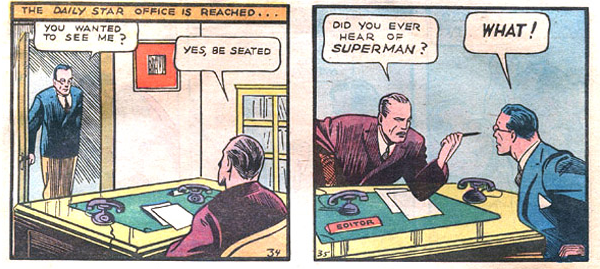
In virtually every version of Superman, Clark is an exercise in patient self-restraint, the ultimate man pretending day by day to be the ultimate common man. In his early days, this restraint was a superstrongman feat all its own, because Clark was extra pathetic—the better for Siegel, Shuster and the readers to identify with him.
I had crushes on several attractive girls who either didn’t know I existed or didn’t care I existed. So it occurred to me: What if I was really terrific? What if I had something special going for me, like jumping over buildings or throwing cars around or something like that?
Jerry Siegel [11]
Kent looked like Shuster, who later lifted weights for five years but never developed the bodybuilder’s confidence.[12] If Kent’s daily humiliations echoed Siegel’s past, they also predicted part of Shuster’s future.[13] When Shuster’s worsening eyesight drove him out of cartooning, he went back to deliveries, showing up at his former publisher carrying a package and wearing a ratty, worn-out suit.[14]
It’s not hard to imagine nerdy Shuster stammering “Sign here, please” in the same voice that Kent used to ask Lois, on their first date, if it wouldn’t be “reasonable” to let a bullying gangster have just one dance with her.[15]
Yet Shuster also drew Clark with a rock-hard physique that threatened to burst out of his jacket and pants at any moment. Every so often, after meekly tolerating an editor’s blustering or Lois’ icy contempt, “Clark” would crack a smile: if only they knew. For him, the angst Siegel and Shuster had felt in real life was just a pose, a suit he put on sometimes. And then he’d hear someone in trouble and strip off his shirt to reveal the S-shield underneath. The red trunks would soon follow. Underwear, for the underself.[16]
It was all just a game. Everything was going to be all right. Superman cheerfully presided over a world of bright rainbow colors where hurts and humiliations were temporary. Indeed, after a couple of years he developed a code against killing—a code most superheroes also followed.[17]
They also imitated the briefs, especially his most immediate peers—the original versions of Batman, Robin, Hawkman, Hourman, Starman, Dr. Fate, the Spectre, the Atom, and the Star-Spangled Kid all rocked the look as seen below. [18] And yes, more than half of those heroes also followed his “Somethingman” naming convention.
The 1960s and 1970s still saw plenty of new trunks-wearers among Avengers like Giant-Man and the Vision, mutants like Magneto, and gods like Orion. The Thing wore only trunks, and the Hulk torn purple pants. Other gods and mutants (Thor, Darkseid, the early X-Men) wore onesies broken up with a belt.[19] Strangely, two X-Men who each disdained the other’s sense of style—Cyclops and Wolverine—went full trunks-over-pants from the 1970s into the 1990s.[20]
This tendency to assign the look to gods and mutants, though, instead of more central figures like Captain America, Mister Fantastic, and Spider-Man, may have been an early sign that it was on its way out. These newer Marvel characters stood out from the first generation by being more fully realized people in their civilian identities, if not eliminating the dual identity altogether. Of the marquee Marvel heroes, only Thor, whose fashions and godly nature made him the exception that proved the rule, was introduced with a Clark Kentish self-denying secret identity.[21]
Superman’s influence continued to erode as the decades wore on. Newer heroes showed less interest in the code against killing or in names ending in “-man.”[22] And costume redesigns left the trunks behind. The X-Men got into black leather for a while, and their later, more colorful costumes still left the briefs out.[23]
Tim Burton’s 1989 Batman film “de-briefed” comics’ second most famous underwear wearer. Batman never went back to the briefs in any succeeding movies: they began to fade from the comics as well, as shown in this sample of Ben Moore’s larger survey of Bat-suits seen in various media, covering the period from 2005-2012.[24]
The look could still show up in the deliberately retro stylings of a film like The Incredibles; despite fashionista Edna Mode’s disdain for capes and insistence that “I never look back, darling, it distracts from the now,” her creations had an old-fashioned flair that matched the traditional values of their wearers, the kind of nuclear family that seemed to headline most sitcoms from the 1950s to the 1980s.[25]
Superman, for many years, seemed content to be a bit old-fashioned. His brand hadn’t been about “cool” for a long time: it was more about safety and stability. The comic-book Superman of 1962 or 1988 was more scientist than slugger, often approaching problems from a cool remove. His peers honored him as the one who came first, and therefore someone who didn’t need to follow the trends. He had, after all, defined them.[26]
Nevertheless, as superheroes and popular entertainment in general grew increasingly impatient with the “no kill rule,” the temptation to challenge Superman for wearing last year’s morals was overwhelming. The movies of the 1970s and 1980s danced around the issue by making Superman’s foes inanimate[27] or leaving their fates uncertain.[28] But many of his best-loved adventures, the ones that could claim to influence his canon, saw him sorely tempted to end a life—or even saw him succumb.
However, this was always an ending for the character as we knew him, as proved by what came next. In one such story, Superman instantly punished himself by giving up his super-powers and retiring.[29] In another, he died along with his foe.[30] In a third, he had a mental breakdown and went on a long journey of soul-searching before returning to duty with an even firmer vow, “Never again.”[31] In multiple stories of a world not our own, a world gone wrong, Superman deciding to kill is his first step toward villainy.[32] And at least once, he used magicians’ stage tricks to fool the world into thinking he’d broken his rule—just to show how terrible a Superman unchecked by restraint would be.[33]
The conservatism is unmistakable but charming. Nearly all fictional franchises create a moral universe that rewards readers for following them, and Superman is no exception. However much he struggled with it, refusing to kill would always be The Right Choice. Other heroes would always look to him for guidance, saluting his cape as if it were the flag. Underwear on the outside of your pants totally works.
The super-briefs stayed on for generations, in comics, movies, TV, Halloween costumes and branded, official kids’ underwear—an incentive to finish toilet training if ever there was one. [34]
And then everyone seemed to reject them at once. In 2011, Jim Lee redesigned all DC Comics’ top-selling characters, giving them the scratchy, slightly self-conscious “edginess” that had made Lee famous.[35] But the artist who had kept Cyclops and Wolverine in trunks now broke precedent. The red of Superman’s trunks shifted to his belt, and its buckle took a shape echoing the chest symbol. The trunks vanished.
I think you have to go for the core elements that are critical to the costume and freely change what looks dated… For me, the red trunks on Superman, you didn’t notice. It gets colored in blue anyhow.[36]
In the same year’s Action Comics, Grant Morrison and Rags Morales emphasized the populist strain in Siegel’s early, Depression-era stories. Theirs was a Superman for the 99 percent, and his costume was the believable result of a reporter’s salary: a screen-printed T-shirt, short cape, and jeans. [37] Morrison explained:
We felt it was time for the big adventures of a 21st-century Paul Bunyan who fights for the weak and downtrodden against bullies of all kinds, from robot invaders and crime lords to corrupt city officials. The new look reflects his status as a street-level defender of the ordinary man and woman.[38]
The filmmakers of 2013’s Man of Steel found the trunks clashed with their concept of the costume as alien armor. Even director Zack Snyder, whose adaptation of Watchmen had featured two trunks-over-pants designs to the comic books’ one,[39] now found himself breaking precedent.
The costume was a big deal for me, and we played around for a long time. I tried like crazy to keep the red briefs on him. Everyone else said, “You can’t have the briefs on him.” I looked at probably 1,500 versions of the costumes with the briefs on.[40]
Who stole Superman’s undies? Morrison takes responsibility for his part in it, Lee shrugs about careless colorists and readers, Snyder bows to the input of unnamed advisors. Their earlier output, though, suggests they had no dislike for the design, just a need to follow popular taste rather than acting as if Superman still shaped it. But fashion, as ever, sends a message about its wearer.
In Man of Steel, the blue is navy, the yellow rusty and gritty. Smallville’s Clark operates without a costume at all. Both versions of Superman are painfully unsure of themselves, closeted, desperate, and far less successful than earlier versions at preventing collateral damage.[41] Smallville averaged one death per episode in each season.[42] Superman’s first TV outing, The Adventures of Superman, averaged none—and lasted six seasons to Smallville’s ten.[43]
Analyst Charles Watson puts the Man of Steel death toll at 129,000, with the last of those deaths by Superman’s own hand.[44] Contrast this with Superman: the Movie, in which Superman saves everyone at risk from a devastating earthquake except Lois Lane, whom he then rescues via time travel. Man of Steel opened in eight times as many theaters as Superman: The Movie.[45] An influential new beginning, and by his old standards, an inauspicious one.
Man of Steel Superman may scream in anguish after killing General Zod, but unlike in the other stories where he crosses that line, he seems to get over it pretty fast. One scene later, he’s cheerfully knocking an Army drone out of the sky. He actually seems more relaxed and happy after the killing is done! No doubt Lois’ approval helps, but even so.
Man of Steel screenwriter David Goyer appears to be weaving some acknowledgments of that issue into its sequel.[46] He would like to assure you that the Superman you remember from your childhoods isn’t gone—he’s just not fully reborn yet.
Our movie was, in a way, Superman Begins; he’s not really Superman until the end of the film. We wanted him to have had that experience of having taken a life and carry that through onto the next films. Because he’s Superman and because people idolize him, he will have to hold himself to a higher standard.[47]
It’s true that Smallville and Man of Steel focus on a young Superman who hasn’t had a chance to become the graceful legend of earlier works. But these have been the portrayals to reach the widest audience in the last decade. [48] Even in current comics, though they have a lighter color scheme and mood, he’s an impulsive younger man with a quick temper.[49] The latest Superman project to be announced, TV’s Krypton, will take place thirty years before his birth.[50]
Put it all together and you’re left with the impression that Superman’s 21st-century caretakers would rather invoke the smiling, life-preserving, cool-headed circus superstrongman than actually show him. Will the next film change that? Will it give him the power and certitude to preserve all intelligent life in his path with a calm soul and a wink at the viewer? Or is that Superman no longer filmable, a relic to be tossed out like a pair of outgrown briefs?
Tights may tell.
[1] 1978’s Superman: The Movie earned nearly six times its budget and spearheaded the only superhero film franchise of the following decade.
[2] Some variation of Super Friends, always with Superman as the headliner, appeared on TV from 1973-1986.
[3] Eco and Natalie Chilton. “The Myth of Superman. The Amazing Adventures of Superman. Review.” Diacritics, 2(1), pp. 14-22. Spring 1972.
[4] Ellison, Foreword to Dennis Dooley and Gary Engle, Superman at 50: The Persistence of a Legend, 1987.
[5] Oxford English Dictionary entry, 2014. Found via Google search, November 22, 2014.
[6] Batman later used gadgets as sort of substitute super-powers, but other figures—the first Atom, Wildcat, and the Spirit, among others—used nothing but ordinary fists.
[7] Jerry Siegel (illustration by Joe Shuster), “The Reign of the Superman,” Science Fiction: The Advance Guard of Future Civilization #3, 1933.
[8] Les Daniels, Superman: The Complete History, 2004, p. 17.
[9] Jerry Siegel and Joe Shuster, Action Comics #1, 1938.
[10] Grant Morrison, Super Gods: What Masked Vigilantes, Miraculous Mutants and a Sun God from Smallville Can Teach Us About Being Human, 2012.
[11] Gerard Jones, Men of Tomorrow: Geeks, Gangsters and the Birth of the American Comic Book, 2005, p. 63.
[12] Tom Andrae with Geoffrey Blum and Gary Coddington, “The Birth of Superman,” Nemo #2, 1983.
[13] Craig Yoe, Secret Identity: The Fetish Art of Superman’s Co-creator Joe Shuster, 2009; Brad Ricca, Super Boys: The Amazing Adventures of Jerry Siegel and Joe Shuster—The Creators of Superman, 2013.
[14] Joe Simon, My Life in Comics, p. 188, 2011.
[15] Jerry Siegel and Joe Shuster, Action Comics #1, 1938.
[16] Alex Ross for Alex Ross and Paul Dini, Superman: Peace on Earth, p. 7, 1938.
[17] Editor Whitney Ellsworth was the driving force behind this rule, as early as 1940, years before the Comics Code Authority.
[18] Art by Jerry Ordway, Who’s Who in the DC Universe #12, 1986.
[19] Tim Leong, “A Venn Diagram of Superhero Tropes,” Super Graphic: A Visual Guide to the Comic Book Universe, 2013.
[20] Art by Jim Lee for X-Men #11, 1992.
[21] Dr. Donald Blake is more complicated than we can cover here,
[22] Wikipedia’s “List of notable superhero debuts” shows a tapering off of such names after the 1960s.
[23] Grant Morrison and Frank Quitely, New X-Men #114, 2001; Joss Whedon and John Cassaday, Astonishing X-Men #1, 2004.
[24] Selected from Ben Moore’s 2012 “Batman Infographic: Every Significant Bat-Suit Ever,” found at Screen Rant, http://screenrant.com/batman-infographic-every-batsuit-benm-144238/.
[25] Brad Bird, The Incredibles, 2004.
[26] Image by Jim Lee for DC Comics.
[27] In Superman: The Movie and Superman Returns, natural disasters are the chief problem; in Superman III and IV, the main villains are destroyed but arguably not truly alive.
[28] Superman II.
[29] Alan Moore, Curt Swan and Kurt Schaffenberger, Action Comics #583, 1986. Source of the image below and the last “Silver Age” Superman story.
[30] Dan Jurgens, Superman #75, 1992. The famous, notorious “Death of Superman.”
[31] John Byrne, Superman #22, 1988; Jerry Ordway, Adventures of Superman #450, 1989; Roger Stern and Kerry Gammill, Superman #28, 1989; George Perez, Action Comics #649, 1989. John Byrne’s last Superman story, and a heavy influence on Man of Steel in terms of who Superman kills and why.
[32] Central premise of the video game Injustice: Gods Among Us, released in 2013, ongoing storyline in the Justice League/Justice League Unlimited animated series (2001-2006) and invoked in the climax of 1996’s Kingdom Come by Mark Waid and Alex Ross.
[33] Joe Kelly and Doug Mahnke, Action Comics #775, 2001. Adapted into a 2012 direct-to-DVD animated film, Superman vs. The Elite.
[34] Photo from http://savinginsalinas.blogspot.com/2011/09/yard-sale-finds.html. Superman has had many adaptations but this was true of virtually all of them until 2011.
[35] Geoff Johns and Jim Lee, Justice League #1, 2011 (image source), and George Perez, Superman #1, 2011. Lee’s career goes back to 1987.
[36] WonderCon 2013 panel, “WC13: Jim Lee Talks DC, Answers Fan Questions and More!,” Comic Book Resources, March 30, 2013, http://www.comicbookresources.com/?page=article&id=44604.
[37] Grant Morrison and Rags Morales, Action Comics #2, 2011.
[38] Dareh Gregorian, “Bird? Plane? Superdude!,” The New York Post, July 18, 2011.
[39] Nite Owl wore them in both versions, but Ozymandias picked them up in the movie. Comics 1986-1987, film 2009.
[40] Reed Tucker, “‘Steel’ this movie,” The New York Post, November 25, 2012. Image from Man of Steel, 2013.
[41] In addition to the film itself, see Emma Dibdin, “‘Man of Steel’: Zack Snyder defends Superman’s ‘collateral damage,’” Digital Spy, August 30, 2013.
[42] According to smallville.wikia.com. In some seasons it was as high as three.
[43] 1952-1958; 2001-2011.
[44] Graphic by Chris Ritter, “The Insane Destruction That the Final ‘Man Of Steel’ Battle Would Do To NYC, By The Numbers,” Buzzfeed, http://www.buzzfeed.com/jordanzakarin/man-of-steel-destruction-death-analysis, June 17, 2013.
[45] Box Office Mojo. http://boxofficemojo.com.
[46] Devin Faraci. “Find Out Superman’s Situation In BATMAN V SUPERMAN,” Badass Digest, December 15, 2014.
[47] 2013 speech at the BAFTA and BFI Screenwriters’ Lecture series.
[48] 2006’s Superman Returns was far less profitable and problematic in a different way.
[49] Johns, Lee, and Morrison have confirmed this is deliberate.
[50] Lesley Golberg, “Syfy, David Goyer Developing Superman Origin Story ‘Krypton,’” The Hollywood Reporter, December 8, 2014.
Blog: Read Roger - The Horn Book editor's rants and raves (Login to Add to MyJacketFlap)
JacketFlap tags: Out of the Box, playtime at the office, librarians with superpowers, superheroes, Featured, Add a tag
 This week Roger talked with living-comics-legend Stan Lee about his new book Zodiac. That made us think of Roger as a superhero: his bow tie doubles as a boomerang! to chase down bad-guys! and retrieve books off high library shelves! It also made us think of Roger in tights and Spandex, which just made us giggle. [Ed. note: You laugh NOW…]
This week Roger talked with living-comics-legend Stan Lee about his new book Zodiac. That made us think of Roger as a superhero: his bow tie doubles as a boomerang! to chase down bad-guys! and retrieve books off high library shelves! It also made us think of Roger in tights and Spandex, which just made us giggle. [Ed. note: You laugh NOW…]
We ask: do you know any superhero librarians? Either librarians who could be existing superheroes (So. Many. Catwoman. Jokes.) or those who could helm their very own, all-new Marvel franchises. Admittedly, Bow-Tie Man isn’t the most scintillating. What are some other ideas?
I’ve always thought K. T. Horning must be able to fly, for example. And Julie Roach is always smiling. But I’m not saying she’s The Joker (though, like Heath Ledger, may he rest in peace, she is cute as a button).
You can also share your thoughts here, by letting us know how you library.
Also, is Stephen Savage’s Supertruck the cutest superhero around or what?
The post Look! Up in the sky! It’s…Super Roger! appeared first on The Horn Book.
Blog: Shelf-employed (Login to Add to MyJacketFlap)
JacketFlap tags: graphic novel, book review, fantasy, family life, superheroes, series, sci-fi, J, Add a tag
 I have been busy lately with review and blogging obligations, as well as work and preparation for the holiday season, but I did take time out to read a copy of Elizabeth Rusch's graphic novel, Muddy Max: The Mystery of Marsh Creek. Thanks to the hard-working intern who brought it to my attention and supplied me with a copy.
I have been busy lately with review and blogging obligations, as well as work and preparation for the holiday season, but I did take time out to read a copy of Elizabeth Rusch's graphic novel, Muddy Max: The Mystery of Marsh Creek. Thanks to the hard-working intern who brought it to my attention and supplied me with a copy.
Rusch, Elizabeth. 2014. Muddy Max: The Mystery of Marsh Creek. Kansas City, MO: Andrews McMeel. Illustrated by Mike Lawrence.
Max lives in the aptly-named suburban town of Marsh Creek. In addition to the marsh on the outskirts of town, mud is everywhere in town as well, making it almost impossible for the child of neat-freak parents to stay clean! Max becomes suspicious of his parents'secretive habits, frequent trips to the marsh, and fanatical obsession with his cleanliness. When he accidentally discovers that mud gives him superpowers, he and his friend Patrick become determined to figure out exactly what is going on in Marsh Creek.
This is an easy-to-read graphic, sci-fi novel that should be popular with younger kids and reluctant readers. The panels are easy to follow, with simple, but expressive drawings in muted browns and grays that reflect the book's muddy locale. Hopefully, future installments will add some dimension to the Max's female friend. Not willing to completely divest herself of her nonfiction roots, Rusch adds some real science about mud and its denizens in the back matter.
I predict that more than one member of my book club will want to take this one home. I'll have to place some holds on library copies.
A Teacher's Guide to Muddy Max is available here.
Elizabeth Rusch is also a talented author of nonfiction. Last year I reviewed her book, Volcano Rising.
Blog: The Open Book (Login to Add to MyJacketFlap)
JacketFlap tags: Diversity, DC, marvel, apple, superheroes, wonder woman, Musings & Ponderings, aquaman, black panther, jason momoa, tim cook, Lee & Low Likes, Diversity, Race, and Representation, gal gadot, dawn of justice, apple ceo, batman vs superman, Add a tag
Happy Halloween everyone! We’ve got something even better than treats today: great news in diversity!
Appl e CEO Tim Cook recently came out in an editorial published by Bloomberg Businessweek, saying that he is “proud to be gay,” and making him the first openly gay leader of a major U.S. company. This was the first time Cook addressed his orientation publicly, saying, “I don’t consider myself an activist, but I realize how much I’ve benefited from the sacrifice of others,” Cook wrote. “So if hearing that the CEO of Apple is gay can help someone struggling to come to terms with who he or she is, or bring comfort to anyone who feels alone, or inspire people to insist on their equality, then it’s worth the trade-off with my own privacy.” With more states and people accepting gay marriage and supporting LGBTQ rights, Cook’s move is inspirational and will hopefully lead to more acceptance within the workplace.
e CEO Tim Cook recently came out in an editorial published by Bloomberg Businessweek, saying that he is “proud to be gay,” and making him the first openly gay leader of a major U.S. company. This was the first time Cook addressed his orientation publicly, saying, “I don’t consider myself an activist, but I realize how much I’ve benefited from the sacrifice of others,” Cook wrote. “So if hearing that the CEO of Apple is gay can help someone struggling to come to terms with who he or she is, or bring comfort to anyone who feels alone, or inspire people to insist on their equality, then it’s worth the trade-off with my own privacy.” With more states and people accepting gay marriage and supporting LGBTQ rights, Cook’s move is inspirational and will hopefully lead to more acceptance within the workplace.
From left: Robert Downey Jr. (Iron Man), Chadwick Boseman (Black Panther), and Chris Evans (Captain America) at a Marvel event in Hollywood
Marvel just recently announced their next phase of superhero movies and we’re excited to see that it’s going to include a Black Panther movie! The Black Panther (T’Challa) was the first black superhero in American comics. We’re also looking forward to seeing Jason Momoa as Aquaman and Gal Gadot as Wonder Woman! DC announced that Momoa would be playing Aquaman in the highly anticipated “Batman vs. Superman: Dawn of Justice,” and the Wonder Woman movie will premier in 2017.
Have you heard more good news in diversity? Let us know in the comments!
Filed under: Diversity, Diversity, Race, and Representation, Lee & Low Likes, Musings & Ponderings Tagged: apple, apple ceo, aquaman, batman vs superman, black panther, dawn of justice, DC, gal gadot, jason momoa, marvel, superheroes, tim cook, wonder woman
Blog: The Children's and Teens' Book Connection (Login to Add to MyJacketFlap)
JacketFlap tags: Graphic Novels, Comics, Marvel, superheroes, book spotlight, The Children's and Teens Book Connection, comics and graphic novels, Guardians of the Galaxy by Abnett & Lanning: The Complete Collection Volume 1, Add a tag
With the fabric of the universe torn, all that stands between us and invading horrors is a team of cosmic misfits. Led by Star-Lord, the newly-minted Guardians of the Galaxy include a who’s who of the mightiest -and most bizarre – protectors the stars have ever seen! Rocket Raccoon, Drax the Destroyer, Groot, Gamora, Adam Warlock, Mantis, the all-new Quasar, Cosmo the telepathic space dog and more take on the universe’s most dangerous menaces…and have fun while doing it!
COLLECTING: GUARDIANS OF THE GALAXY (2008) 1-12
Series: Guardians of the Galaxy
Paperback: 296 pages
Publisher: Marvel (August 12, 2014)
Language: English
ISBN-10: 0785190643
ISBN-13: 978-0785190646
Blog: Kid Lit Reviews (Login to Add to MyJacketFlap)
JacketFlap tags: Books for Boys, gibbs smith, Bart King, supervillains, 4stars, Library Donated Books, The Big Book of Superheroes, animal superheroes, Greg Paprocki, learn how to become a superhero, sidde kicks, super trash talk, Middle Grade, Favorites, superheroes, children's book reviews, Add a tag
written by Bart King
illustrated by Greg Paprocki
Gibbs Smith 4/01/2014
978-1-4236-3397-6
Age 8+ 288 pages
.
“Supervillains started quaking in their boots when they heard Bart King was creating a foolproof handbook that would teach superheroes how to interview and hire sidekicks, customize secret lairs—oh, and how to perfect hand-to-hand and foot-to-butt combat techniques! So, if you have a burning desire to fight evildoers, and a bit of allowance money to purchase this book, grab your battle costume disguise and join the fight for good!”
Opening
“Welcome to the world of superheroes! I have good news. By reading these words, you just became an honorary superhero. Yay!”
So You Want to be a Superhero (aka About the Book)
It begins at the beginning: you’ve made your decision to become a superhero, fighter of evil, doer of good. Now you need to learn how to act and look like a superhero, starting with your superpower. What will it be? King gives you the 15 most popular superpowers, though there are many, many more to choose from. Then you must act like a superhero. This section gives you situations and asks you to pick the superhero answer. Many answers are further impressed upon your mind through the use of black and white illustrations.
Ways to become a superhero, short of reading the entire The Big Book of Superheroes, includes becoming an orphan, taking your vitamins, and having a rotten childhood. Those are but a few of the ways to shortcut your way to becoming a superhero. Personally, I like “Be a Handsome, Genius Millionaire,” but being hit by cosmic rays works, too. Once you tell your parents you are a superhero, the real training begins.
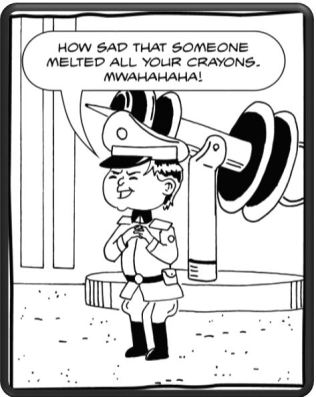
Know when to fight—and with which weapon—and know when to run, I mean retreat. What does a superhero say? The section called “Zingers and Battle Cries—Speaking Superhero!” will help you find a battle cry, a motto, and how to super trash talk. With super training complete, who will be your toughest foe? Rugrats! That’s right, little kids, some of whom may have their own version of a superpower. You can’t just hold these rugrats at arm’s length and laugh. No, you need to know how to control supertantrums.
You need a supername. One suggestion is to find a cool word and spell it backwards, such as El Carim (miracle) or Repus (super). Repus would be a good name for a feline superhero. Add a “p” and get the name Repups, the perfect name for Repus’s canine sidekick. Yep, animals can be superheroes. Your dog or cat might be on a super mission right now. You also need a costume. Maybe a cape would be good with a utility belt to hold your utilities. The Fantastic 4 have great costumes according to King. The Human Torch had flaming underwear, hopefully not as he wore them.
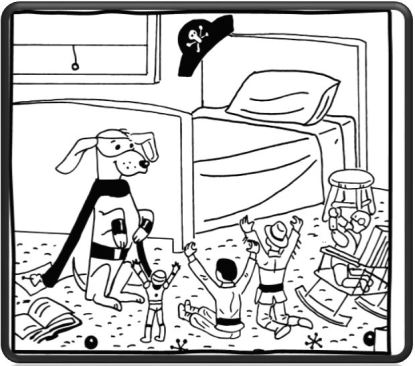
Superheroes need to know the difference between right and wrong. They need ethics. Can you learn this? Check out the quiz to see where you stand. If you have a secret identity, keep it a secret along with any super powers you may have. Secrecy is very important to a superhero. On the wrong side are supervillains and ethically challenged people. It’s best to keep an eye out for some of the worst. Those would be the jokers, mad scientists, and high school students (the most abundant).
Review
If you want to be a superhero, start with The Big Book of Superheroes. This book is more like a handbook for good rather than a literary book anyone can find in a bookstore (but you can). This book is the superhero’s bible. Everything you would ever need to know to become a superhero is in The Big Book of Superheroes. I like The Big Book of Superheroes. I had never thought of becoming a superhero, but after reading this book/handbook, it is hard not to want to join up forces with the likes of Batman, Superman, and Super Tot. There is a lot of common sense within the pages of The Big Book of Superheroes, such as,
“The more you know, the less you don’t.”
Who can argue with that? One of the best sections is the “Superpower Activity.” These boxed areas contain activities kids can immediately do, including a list of everything they will need. Kids can add to their super costume by making super goggles, utility belts, and power bands. There is even a sneaky way for superheroes to calm a rugrat using a balloon and one command. Kids will have loads of fun with these silly activities. The pop quizzes are not as abundant as the activities, but they are just as much fun for the superhero know-it-all . . . or do they? All answers are included.
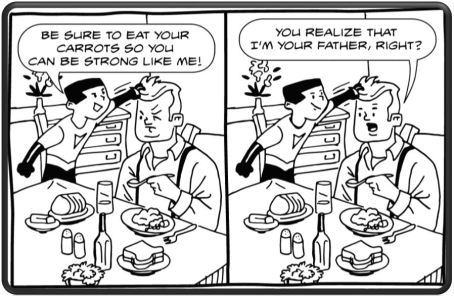
The black and white cartoonish illustrations show kids acting out some portion of the text. They are just what I would expect to see in a book about superheroes. The illustrations help break up the text, add humor, and sometimes help clarify the text. King writes The Big Book of Superheroes using text, lists, asides, blue boxes of comic facts, activities, pop quizzes, and comic illustrations, which all keep the book hopping and kids interested. King’s lists, found in every chapter, include things such as,
The 10 Most Underrated Superpowers,
The 10 Lamest Superpowers,
The Top 6 Tips for Parents of a Superhero.
He adds hunks of factual material, such as Superman’s original slogan, and fun comic book facts to teach kids. With Superman’s slogan, King tries to teach kids to come up with their own slogan, motto, or catch phrase. If kids love comics, superheroes, or villains they will love these easy to find snippets by King. These sections are in blue text, making them stand out from the page.
The Big Book of Superheroes, nicely bound in hardcover with bright white pages, is a substantial book filled with enough superhero information to keep a middle grader’s nose between the pages for quite some time. It is the perfect book for kids who love superheroes. Boys may seem the logical choice for The Big Book of Superheroes but girls will like this too. King includes many tidbits and facts about different comic book heroes that I found fascinating. In regards to becoming a superhero by using this book, King wrote,
“Sure, you could read this entire book. But who has that kind of time?”
The same can be said of the book as a whole. No time to read the entire book, pick out the section you want and return later for the others. Readers will not lose any continuity or meaning by skipping around. If more interested in the supervillain, jump towards the back. Interested in superpowers, head toward the middle. Back and forth can become practical. The one thing that bothered me throughout the book is King’s continued insistence on placing the word “super” before other words, making a new word. Some of King’s new “words” include superbreathe, superspeed, superhealing, superhearing, superintelligence, and supergoggles. These words are not supersmart.
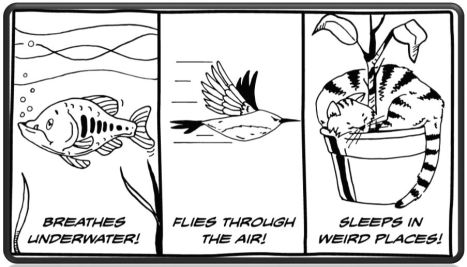
Kids and adults who like supervillains, DC comics, and superheroes like Batman, the Fantastic 4, and one of my favorites, Wonder Dog, will enjoy The Big Book of Superheroes. It will keep readers entertained for hours. Reluctant readers will find The Big Book of Superheroes a great choice for summer reading. The Big Book of Superheroes can help readers become the hero they would like to become, while learning new facts about favorite superheroes or previously unknown superheroes. The appendix and bibliography are great places to continue learning about superheroes. The large book is entertaining on every page. Super-Kids will love The Big Book of Superheroes, the newest Big book by Bart King.
THE BIG BOOK OF SUPERHEROES. Text copyright © 2014 by Bart King. Illustrations copyright © 2014 by Greg Paprocki. Reproduced by permission of the publisher, Gibbs Smith, Layton, UT.
Purchase The Big Book of Superheroes at Amazon—B&N—iTunes—Book Depository—Gibbs Smith—your local bookstore.
Read a hilarious review by Erik and Darth Vader, er sorry. An outstanding review by Darth Vader and ThisKid HERE.
Learn more about The Big Book of Superheroes HERE.
Meet the author, Bart King, at his website: http://www.bartking.net/
Meet the illustrator, Greg Paprocki, at his website: http://gregpaprocki.com/
Find more books at the Gibbs Smith website: http://www.gibbs-smith.com/
.
**Illustrations by Greg Paprocki, from The Big Book of Superheroes, reprinted with permission of Gibbs Smith.
.
ALSO BY BART KING

Bart’s King-Sized Book of Fun
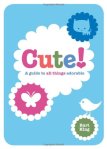
Cute! A Guide to All Things Adorable

The Big Book of Spy Stuff
.
.
.
.
.
ALSO BY GREG PAPROCKI

The Marvelous McCritterson’s Road Trip to Grandmas
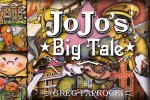
JoJo’s Big Tale

Curious George Animals Puzzle Book
.
.

Filed under: 4stars, Books for Boys, Favorites, Library Donated Books, Middle Grade Tagged: animal superheroes, Bart King, children's book reviews, gibbs smith, Greg Paprocki, learn how to become a superhero, sidde kicks, super trash talk, superheroes, supervillains, The Big Book of Superheroes
Blog: Children's Book Reviews and Then Some (Login to Add to MyJacketFlap)
JacketFlap tags: Picture Books, Superheroes, Add a tag
Send for a Superhero! by Michael Rosen with illustration by Katharine McEwen is the kind of super fun book that makes you stop and wonder why there aren't more picture books about, starring or including superheroes. Then, when you remember that there are quite a few books of this nature you remember that most of the are forgettable - short of Mini Grey's Traction Man Trilogy. Rosen
Blog: Children's Book Reviews and Then Some (Login to Add to MyJacketFlap)
JacketFlap tags: aauthor: Bolton, Graphic Novel, Superheroes, Reading Level 3, Add a tag
SMASH: Trial by Fire, a graphic novel by Chris and Kyle Bolton reads like the handful of superhero middle grade novels that have been published over the last few years, which makes it perfect for an audience reading at a slightly lower level. Jack D Ferraiolo's Sidekicks is fast paced and suspenseful with a great plot twist as well as a poignant look at what it means to
Blog: Children's Book Reviews and Then Some (Login to Add to MyJacketFlap)
JacketFlap tags: Superheroes, New in Hardcover, Reading Level 3, Art and Craft, aauthor: King, Add a tag
Bart King is the undisputed master when it comes to writing fact-filled books for kids that are incredibly fun to read - and do. With The Big Book of Superheroes, illustrated by Greg Paprocki, King covers new territory, exploring the ins and outs of this semi-secret occupation. The Big Book of Superheroes is perfect for any kid with a great sense of imagination and drama, but it is also great
Blog: Children's Book Reviews and Then Some (Login to Add to MyJacketFlap)
JacketFlap tags: Graphic Novel, Superheroes, Reading Level 5, aauthor: Yang, Add a tag
The Shadow Hero is the new, totally awesome graphic novel from Gene Luen Yang and Sonny Liew. Besides being completely entertaining, humorous and suspenseful from start to finish, The Shadow Hero is smart. And The Shadow Hero is diverse in ways that, in less gifted hands, could be didactic and boring. In a time when internet voices - from authors to bloggers to educators to booksellers - are
Blog: Asking the Wrong Questions (Login to Add to MyJacketFlap)
JacketFlap tags: television, essays, superheroes, marvel cinematic universe, agents of shield, Add a tag
Coulson: You're going to lose Loki: Why? Coulson: It's in your nature. Loki: Your heroes are scattered. Your floating fortress falls from the sky. Where is my disadvantage? Coulson: You lack conviction The Avengers, 2012 Sam Wilson: How do we know the good guys from the bad guys? Captain America: If they're shooting at you, they're bad. Captain America: The Winter Soldier, 2014 What a
Add a CommentBlog: Shelf-employed (Login to Add to MyJacketFlap)
JacketFlap tags: book reviews, comic book, superheroes, J, digital audiobook, Add a tag
Recently, I reviewed an audiobook version of a comic book. It sounded crazy to me, but it works! Below is my review as it appeared in the April/May 2014, issue of AudioFile Magazine.
MOLLY DANGER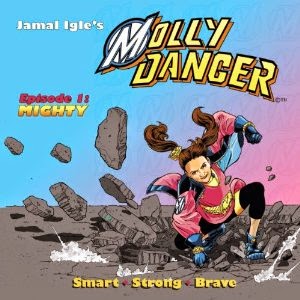
Jamal Igle
Read by Olivia DuFord, Robin Miles, Lance Roger Axt, and a Full Cast
Crunch! Kaboom! Pow! A superhero action comic in audiobook format? Yes! With sound effects including crashing cars, screaming citizens, beeping computers, and whirring helicopter rotors, AudioComics brings this new series to life with a full cast of narrators. Likable Molly Danger is a super strong, immortal 10-year-old alien who is never far from action. Orphaned when her parents' ship crashed to the earth, she was recruited by the Danger Action Response Team (D.A.R.T.) to fight the evil Supermechs, who threaten Earth. Quiet music accompanies Molly's sad and lonely backstory scenes, while techno pop and suspenseful music highlight battle and chase sequences. Multiple narrators and excellent special effects make it easy to follow this fast-moving audio comic. L.T. © AudioFile 2014, Portland, Maine
Children • 1 hr. • Audio Program • © 2013
Copyright © 2014 AudioFile Magazine. Reprinted with permission.
- Want to see the print copy of Molly Danger? In honor of Free Comic Book Day, you can get a free digital copy of Molly Danger/Princeless now at Comixology.
- FREE COMIC BOOK DAY is May 3, 2014, and Molly Danger is one of this year's offerings. Click here to find a participating comic book store near you.
Blog: Noblemania (Login to Add to MyJacketFlap)
JacketFlap tags: superheroes, interview (with someone else), pop culture nostalgia, Add a tag
After a talk I gave at a Virginia elementary school in 11/13, one of the teachers, Nancy Wykoff, introduced herself...as the granddaughter of William Moulton Marston, the creator of Wonder Woman.
Naturally I asked to interview her. Luckily she said yes. (Photos may be forthcoming.)
Your grandfather died in 1947 so I presume you never met him?
No, I never met my grandfather.
According to family who knew him, what kind of person was he?
My grandfather was a kind man. He was brilliant. Very bright. He not only created Wonder Woman, but he created the first lie detector. He loved his children and he loved women!
Any funny stories about him? In particular any funny Wonder Woman-related stories?
He died when my dad was 13 so most of the stories came from my grandmother. Stories say that he modeled Wonder Woman after Elizabeth Marston but my grandmother, Olive Richard, claims that Wonder Woman was designed after her. If you ever see a picture of the two ladies, you would see that indeed Wonder Woman was designed after my grandmother.
Bill Marston had four children with two different women. All the children, three boys and one girl, have Marston as their last name. My grandmother Olive met Bill when she was 19. Bill came home to his wife, Elizabeth Marston, and asked if Olive could come live with them. Elizabeth agreed. Olive was the homemaker and Elizabeth was an attorney for Met Life.
After Bill died, the women raised the kids together and continued to live together until their death. The children were well educated, Andover Prep School and Harvard. My dad was an attorney and Byrne was a doctor. The two children from Elizabeth, Pete and Olive Ann, I am not as close to. Pete and O.A. are still living and live in Connecticut. I am very close to my Uncle Byrne. We see him and his family quite often. He lives in Florida. My dad [came] to Washington D.C. to attend law school, moved to Arlington, Virginia, and I am still here!
Do you know what inspired him to create Wonder Woman?
Bill Marston said that he wanted a superhero that females could identify with. The few that were around then were characters that boys idolized or wanted to be, so he wanted to have a woman superhero. As you can tell, Bill loved women! He certainly created a well-shaped female!
Do you know about any controversy he had to deal with surrounding Wonder Woman?
I don't know if there was any controversy...
Do you what his opinion of Wonder Woman was?
I think he wanted WW to be a female who was strong, self-sufficient, and could help solve the world's problems. She used her lasso to get people to tell the truth (hence the lie detector connection), flew around in her invisible plane, and helped fight crime. What is not to love about that? She came from Amazonia, a land of strong women, goddesses... Remember Bill loved women. Fantasy, strong women, shapely...Wonder Woman.
Is Wonder Woman mentioned on his gravestone?
I am not sure. My dad spent many years of his life being angry at his father. Since there were two women living in his house, neighbors and peers often teased him about being a "bastard child" of Bill Marston. My dad was really confused and pissed off. I have never been to my grandfather’s grave. To be honest, I am not sure where he was buried. I think New York. That is where they were living when Bill died. I will have to find that out for you.
What is the oldest piece of Wonder Woman memorabilia you own?
We own a few of the first sketches for the first comic Wonder Woman. We have the original script for the first comic and we have the first comic book published. We even have the first lie detector! I know, it should be in the Smithsonian or someplace like that!
I understand that your family still owns Wonder Woman. Does that mean that DC Comics needs the family's approval for all Wonder Woman stories and products?
Yes, they need family approval before any decisions are made.
Have you been interviewed before about this?
Never!
Do you pay attention to the narrative changes DC has made to the character?
We wish they would go back to the kinder, gentler WW. I am not thrilled with the new look.
Who would you like to see play Wonder Woman in a movie? [NOTE: Question asked before Gal Godot was cast for the 2016 Superman/Batman movie...but no matter, she will not be the last actress to portray Wonder Woman.]
I liked Jessica Biel. They also had another choice, a woman from Mexico, I think. She was a good choice. I think he character needs to be young to attract the young girl audience. Too old and you lose that. I can't tell you how many kids at my school have WW stuff. The girls love her!
Were you ever Wonder Woman for Halloween?
Yes! So was my daughter!
What do the kids in the family think of the family's connection to Wonder Woman?
They think it is awesome! They so want a movie to be made. They think it isn't fair that Batman and Superman have had so many movies already. When they tell friends that their great grandfather created WW, most friends don't believe them!
On a side note, my great grandmother is Margaret Sanger. When the kids mention her, then there is total doubt! That is what used to happen to me when I was younger. My friends would say, “There is no way your dad's dad created WW and your great-grandmother started Planned Parenthood!” It is true!
My son's middle name is Marston and my daughter's middle name is Sanger…so it continues... :)
A stage play about Marston.
View Next 25 Posts

















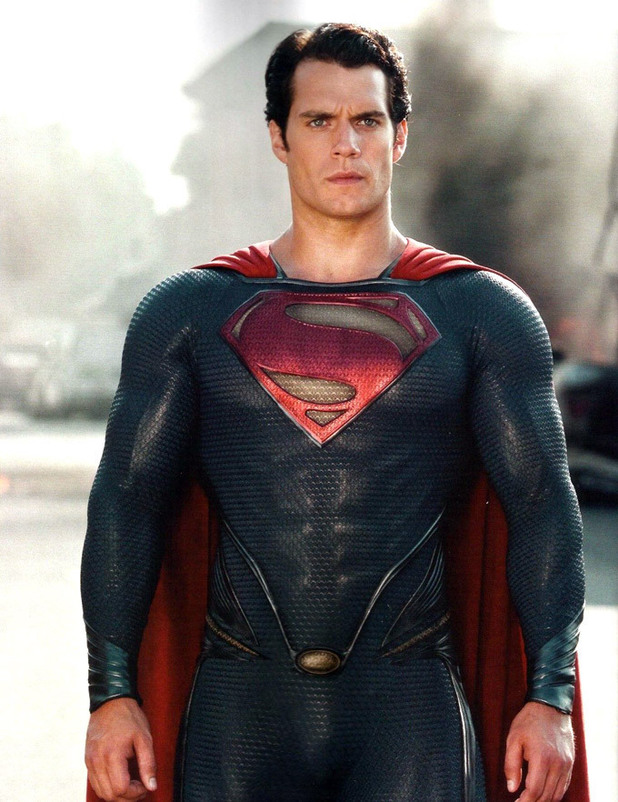

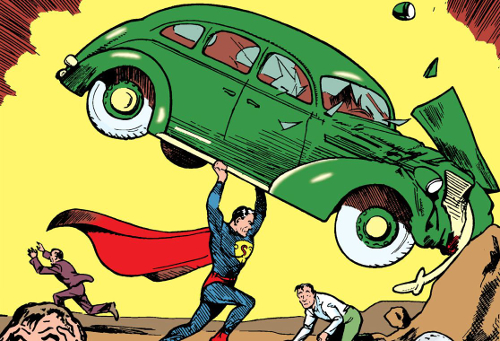

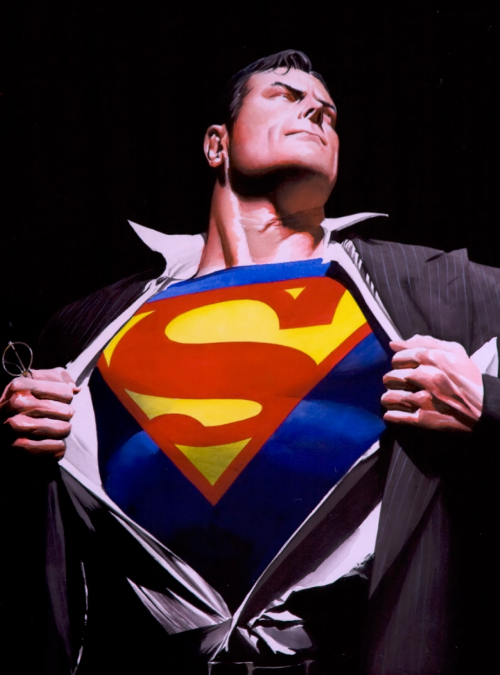



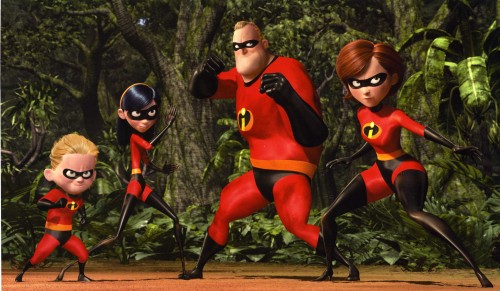






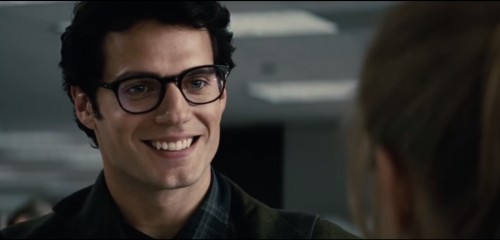

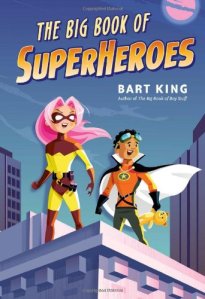 The Big Book of Superheroes
The Big Book of Superheroes
Every night I pass by those two dignified black stone figures on Central Park West. I always tip my hat to Lincoln and say, “Good evening Mr. President” … and I always wave down 77th street, where Frederick Douglas guards the side door, and call out: “You too Mr. Douglas.”
… and now I have to see THIS !